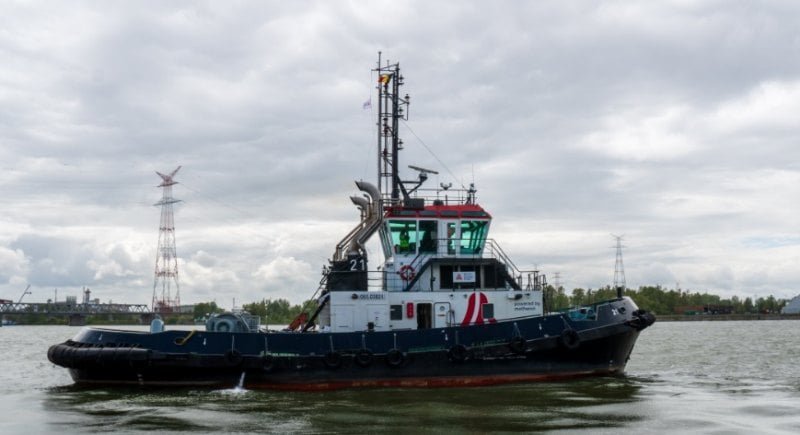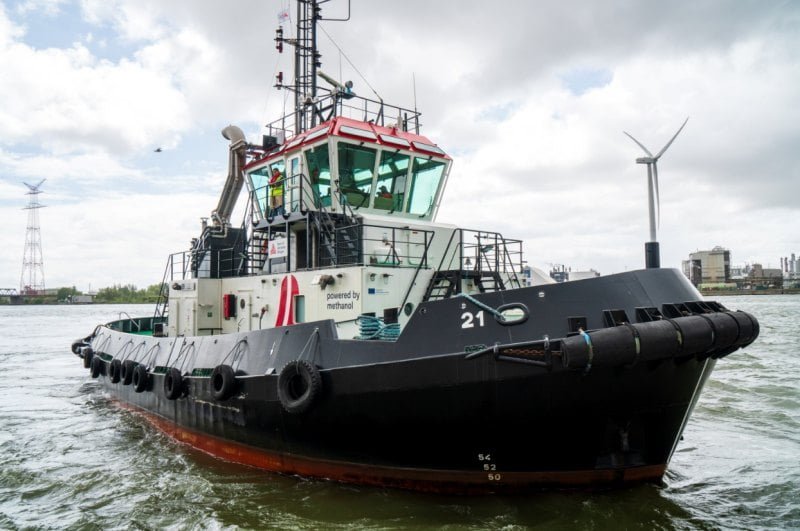The Port of Antwerp-Bruges presented a world premiere: the Methatug. This tugboat, which runs on methanol, is part of a greening program for the port’s fleet and is an important step in the transition to a climate-neutral port by 2050. The project is financed by the European research program Horizon 2020 and is part of the FASTWATER project, which aims to demonstrate the feasibility of methanol as a sustainable marine fuel for the shipping industry.
World’s First Methanol-Powered Tugboat
Methanol is one of the fuels of the future and produces lower emissions, an important factor in the Port of Antwerp-Bruges ambition to be climate-neutral by 2050. The world’s first methanol-powered tugboat, the Methatug, was unveiled today in Antwerp. Methanol can be produced from renewable sources, is a clean fuel, and can be used for both brand-new ships and retrofits because it is liquid under ambient conditions. For the Methatug, the engines from an existing tugboat were converted into ‘dual fuel’ engines, which means they run on a mixture of methanol and traditional fuel. The 30-meter-long tugboat has a traction force of 50 tons and can store 12,000 liters of methanol, enough for two weeks of tug work.
FASTWATER Project
The Methatug is part of the European FASTWATER project, which aims to demonstrate the feasibility of methanol as a sustainable fuel for the shipping industry and is financed by the European research and innovation program Horizon 2020.
In addition to the Port of Antwerp-Bruges, various other partners from the FASTWATER consortium are involved in this project: the Swedish ship design agency ScandiNAOS, the Belgian engine manufacturer Anglo Belgian Corporation, the German company Heinzmann responsible for the methanol injectors, Ghent University for the emission monitoring program, and the Canadian methanol supplier Methanex during the trials. In the FASTWATER project, the conversions to methanol propulsion of a pilot boat in Sweden, a river cruise ship in Germany, and a coastguard vessel in Greece are also elaborated. De Wit Bunkering will supply the Methatug with methanol via truck-to-ship bunkering at the Port of Antwerp-Bruges Nautical Operational Cluster (NOC).
Green Fleet and Multi-Fuel Port
This world premiere forms part of a comprehensive greening program for the Port of Antwerp-Bruges’ own fleet, which strives to systematically integrate the most environmentally friendly technologies available. So far, the Hydrotug 1, the first tugboat to run on hydrogen, and energy-efficient RSD tugboats have already been added to the fleet. Another electrically powered tugboat will follow later this year, the first in Europe.
As the Fifth-largest bunker port in the world, the Port of Antwerp-Bruges also aims to become a full-fledged multi-fuel port, in which seagoing and inland vessels will be able to bunker not only conventional fuels but also alternative, low-carbon fuels such as methanol, hydrogen, or electricity. In early April, the first methanol bunkering with the deep-sea vessel Ane Maersk took place in Antwerp, a new milestone in terms of this ambition.
Jacques Vandermeiren, CEO of Port of Antwerp-Bruges: “Together with our partners, we are pioneering innovative technologies for the transition to alternative and renewable energy sources. The Methatug is a new and essential step in our efforts to make our own fleet greener and become climate neutral by 2050. Thanks to projects such as this, we are paving the way and hope to be an example and a source of inspiration for other ports.”
Annick De Ridder, Vice-Mayor of the City of Antwerp and President of the Board of Directors of Port of Antwerp-Bruges: “The fact that we are able to announce another world premiere today in the field of clean energy is fantastic news for our port and for the shipping industry in general. Just like with the Hydrotug, the world’s first hydrogen-powered tugboat, this project confirms our pioneering role in the field of energy transition. The ecosystem of our port platform forms an ideal, large-scale testing ground for this.”
Prof. Sebastian Verhelst, Project Coordinator FASTWATER: “Methanol has everything to become the fuel of the future and play a pioneering role in the greening of the shipping industry. Thanks to the expertise and efforts of the different partners from the consortium, we are now able to take important steps with the Methatug to demonstrate its feasibility.”
Methatug Specifications
- 11-meter width
- 29.5-meter length
- Weight of 584 tons
- 50-ton bollard pull
- Storage of 12,000 liters of methanol
- Two ABC 8DAC dual fuel medium-speed engines

About Port of Antwerp-Bruges
With an overall throughput of 271 million tonnes per year, the Port of Antwerp-Bruges is a critical hub in worldwide trade and industry. The port is a crucial link for handling containers, breakbulk, and the throughput of vehicles. The Port of Antwerp-Bruges is home to 1,400 companies and accommodates the largest integrated chemical cluster in Europe. The port provides, directly and indirectly, a total of around 164,000 jobs and generates an added value of 21 billion euros.
The ambition for the Port of Antwerp-Bruges is clear – to become the world’s first port that reconciles the economy, people, and climate. In addition to growing sustainably, the port also aims to focus on its unique position as a logistics, maritime, and industrial center and to take the lead in the transition to a circular and low-carbon economy. Together with the port community, customers, and other partners, the Port of Antwerp-Bruges is actively seeking innovative solutions for a sustainable future. High on the agenda is its responsibility for the environment and the surrounding society.
Source Port of Antwerp-Bruges

